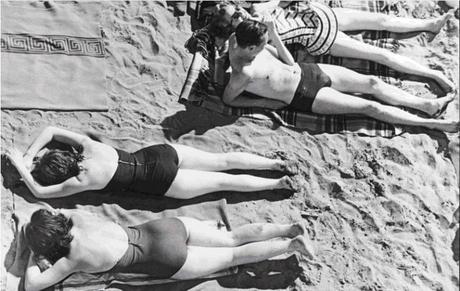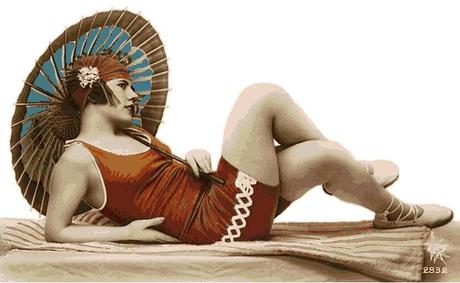
Tanning hasn’t always been in vogue: back in the day, paler skins were prized as a status symbol—only the wealthy could afford to stay out of the sun.What do you think all those bonnets in Pride and Prejudice were for? People went pretty far for pale skin back in the day—for example, there was Queen Elizabeth I, with her famously ghostly complexion. How many layers of foundation do you suppose that took? Some women even went so far to use lead to lighten their skin—of course, they didn’t know they were slowly poisoning themselves.

It wasn’t until the 1920’s that tan skin began to be favored over pale skin. It was a trend that started—where else?—in Paris. In the 1920’s, more-revealing swimsuits started coming into fashion, which led to sunning, which led to…tans. It’s said that Coco Chanel herself was responsible for the popularization of tanning. The 20’s were also a time where it started becoming socially acceptable for women to partake in more outdoor activities, such as tennis and hiking.
Like pale skin in Jane Austen’s time, tan skin in modern society has become something of a status symbol—it means that you have the money to go on expensive vacations to tropical islands; that you have the time to spend hours lying on the beach. Some people also view it as a measure of health: tan people are generally viewed as more fit and athletic. I have a weakness for fashion magazines and a lot of them count tans as an accessory—some of them even say that tanning can make you look slimmer.

By the 1970’s, people were baking themselves to all-get out—it was the 70’s when indoor tanning was first popularized. Although we now know about the dangers of skin cancer, indoor tanning remains a booming industry. Unfortunately, people who frequently use indoor tanning beds are 74% more likely to be diagnosed with a melanoma, and those aren’t statistics you want to take lightly.
If you’re worried about skin cancer (and rightfully so), there’s a third option: sunless tanning.I remember my locker mate back from my track and field days used to slather herself with the stuff—the odor wasn’t exactly what you’d call pleasant, but she certainly had a nice healthy glow (and without risk of skin cancer).
Even though tanning is still largely popular in Western countries, there are many other countries where pale skin is still a symbol of leisure and status. Particularly in India and Korea, skin whitening is another booming business, and one that is gaining traction in the US. BB Creams, which are one of the newest import fads, often contain whitening ingredients, while skin lightening products are available and used for a wide variety of reasons, from treating acne scars to removing over-done tans.
So, pale or tan—I say go with whatever suits your skin naturally! Although you should always be careful as to the amount of time you are exposed to the sun, some amount of natural sun exposure can be healthy for your skin.
Marcela De Vivo is a freelance health writer who specializes in alternative medicine, fitness and skin care. Living in one of the hottest areas of Southern California, she is constantly aware how much sunscreen she needs to protect her skin, while still achieving that perfect summer glow.

